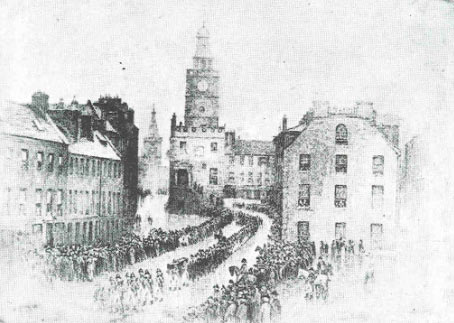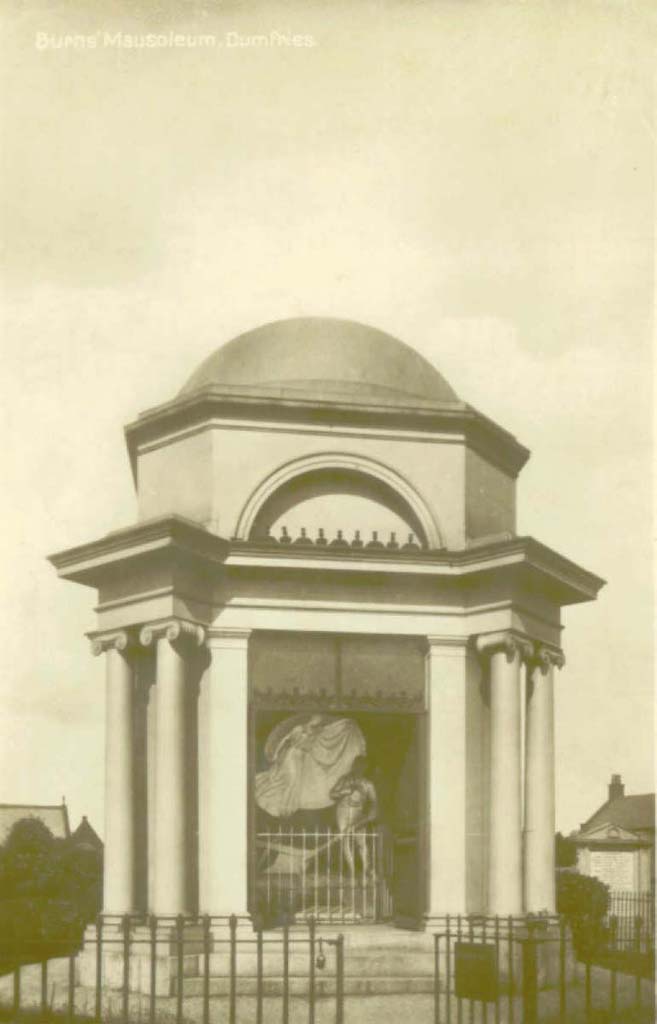|
It was once said of Dumfries, that it was 'the grandest city of the world, for thou hast Burns's grave'. The town of Dumfries is steeped in the history and heritage of Robert Burns and boasts not only the Mausoleum and final resting place of many of Burns's closest friends and associates, but many other landmarks relating to the poet. It may well be said that, in Dumfries, Robert Burns suffered his severest pangs, and yet accomplished many of his proudest achievements.
In November 1791, Robert Burns moved from Ellisland Farm to the town of Dumfries and, along with his wife and family, took up residence in Bank Street - the Stinkin' Vennel. Two years later, in 1793, he moved to the house in Mill Street, commonly called the Millhole Vennel, and which is now Burns Street. It was in this house, and having penned the words, 'I fear the voice of the bard will soon be heard among you no more,' the shadow of impending death crept across the Poet's own fireside clime. In July 1796, he crossed the threshold of the Mill Street house and climbed the stairs to his bedroom for the last time, a very sick man. Although Jean oft-times crept stealthily into his room to soothe his fevered brow, he died in that upstairs room where, from the window he could gaze on the grey Galloway hills. In the room adjoining the bedroom, used as an office and study, Robert Burns wrote nearly one hundred of his best-loved songs, and composed many of his scholarly letters.
Burns Walk, by the banks of the Nith, is one of the beauty spots of Dumfries. It was Robert Burns's favourite stroll, and can best be approached today by turning off the Edinburgh Road at Albany. One then carries on until the old ford at the river is reached.
The Brow Well, 'the meanest, shabbiest little spa in all the world,' is situated on the banks of the Lochar, ten miles south-east of Dumfries, in the parish of Ruthwell. Here, Robert Burns, stricken with rheumatic fever, a 'poor plucked pigeon,' as he pathetically described himself, repaired in a last despairing effort to regain his shattered health. His time was spent in sea-bathing and drinking from the unpretentious 'rusty iron spring' - a tank the size of a dining-table, into which, through an iron pipe, trickled mineral water. All this exercise was, although carried through following medical advice, unfortunately of no avail.
 Robert Burns was buried in St. Michael's Churchyard. His remains were first deposited in a grave in the north-east corner of the old cemetery, in which were afterwards interred those of Mrs. Perochon, daughter of his friend, Mrs. Dunlop of Dunlop. Graves in that vicinity include those of Jessie Lewars (buried next to the Mausoleum) and Jessie Staig; James Gracie the banker, 'man o' worth;' John Bushby, lawyer, 'vintner and factor;' Old Terraughtie, the Maxwell's vet'ran chief; the progenitors of Fergusson of Craigdarroch who, along with others sleep in a quarter full of memories of the Poet. Robert Burns was buried in St. Michael's Churchyard. His remains were first deposited in a grave in the north-east corner of the old cemetery, in which were afterwards interred those of Mrs. Perochon, daughter of his friend, Mrs. Dunlop of Dunlop. Graves in that vicinity include those of Jessie Lewars (buried next to the Mausoleum) and Jessie Staig; James Gracie the banker, 'man o' worth;' John Bushby, lawyer, 'vintner and factor;' Old Terraughtie, the Maxwell's vet'ran chief; the progenitors of Fergusson of Craigdarroch who, along with others sleep in a quarter full of memories of the Poet.
Close to where the Mausoleum now stands, is the family burial ground of Collector John Mitchell, the official superior and intimate of Robert Burns. Also there, is the grave of Thomas Wilson the blind bellman who was a contemporary of the Poet, who died in 1825 and who, in the words of the inscription on his tombstone, 'for the long period of 63 years, summoned the lieges to labour and repose, with the regularity of the clock itself, and may almost be said to have died at his post.'
In 1815, Burns's remains were transferred to the Mausoleum, constructed in St. Michael's Churchyard for a lasting memorial to a great man. It takes the form of a beautifully proportioned Grecian temple and portrays the Genius of Coila finding her favourite son at the plough and casting her mantle over him. Over fifty designs were submitted to the Mausoleum Committee and that of Thomas Hunt of London accepted. The foundation stone was laid with due Masonic ceremonial by William Miller, son of Patrick Miller of Dalswinton, Burns's friend and landlord at Ellisland, who died in 1815 and, in addition to the usual deposit of coins and papers, there was laid in the stone a bottle containing a grandiloquent inscription in Latin, in which Robert Burns is described as 'incomparably the first Scottish Poet of his age.' The Mausoleum was completed in 1817, when Turnerelli's sculpture was erected. Opinions vary on the finished article - praised by some, condemned by others.
Burns's Statue is situated at the head of the High Street in Dumfries and presents the Poet in Carrara marble. It was erected in 1882. There is a pedestal in which are inset panels with inscriptions from Burns's works, and standing on this pedestal, there is the nine-foot statue, depicting Robert Burns resting against a tree trunk in a half-sitting position. His right hand is placed on his heart, while the other holds a posy of daisies. At his feet is a dog, reputed to be his faithful Luath, together with several items emblematic of his works.
Situated on the west side of the River Nith, the recently opened Robert Burns Centre has proved a great attraction to visitors. It houses, in addition to Burnsiana, a useful lecture room, where, during the 1986 Octocentenary celebrations of the town, a local schools debate on the appeal of Burns was held.
With all these attractions, is it little wonder that many visitors, including Burns Clubs, make Dumfries their destination for a summer excursion? The Burns Howff Club of Dumfries has always been ready and willing to act as hosts on such occasions and conduct interested parties around the Burnsian world into which they have come. Over the years there have been visitors from all over the world, along with those from our own country. Dumfries is proud of its Robert Burns heritage, its gates are always open to friends and admirers of Robert Burns. All depart wiser and, on occasion, 'fou and unco happy.'
|